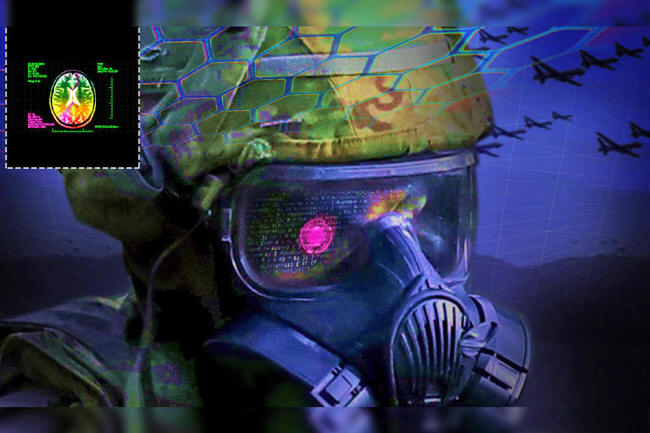|
have unlocked the possibility of futuristic advancements such as controlling swarms of drones via neural implants. (Illustration by Andrew Levin CCDC Chemical Biological Center)
The implant also allows
him to see exactly what each of those drones is seeing, then
digitally integrate this information in his brain and send it as
data to other machines, fellow Soldiers or his command and control
element.
The report bears the
title, 'Cyborg
Soldiers 2050 - Human/Machine Fusion and Implications for the Future
of the DoD.'
...as well as top experts in bioengineering and several related fields drawn from across the DoD. Distinguished outside experts from academia were also included.
The main consumer of this
report is senior Pentagon leadership - the people most in need of
knowing how to ready the nation's armed forces for the magnitude of
technological change to come.
They fell into these four categories:
Each one of these four areas of technology comes with its own set of revolutionary changes.
For example, ocular enhancement could consist of overlaying data streams onto a Soldier's retinal wall and sent up the optic nerve.
But it is unlikely that this data would be understood in the brain as visible light.
In fact,
Similarly, auditory enhancement could not only protect a Soldier from overexposure such as a blast, but also increase sensitivity to low amplitude sounds and even infrasonic and ultrasonic sounds.
As the technology further
matures, the study group foresees Soldiers capable of echo-locating
adversaries in the dark and using imperceptible forms of
communication with each other.
The Soldier has light receptors implanted just under the skin and through carefully orchestrated light impulses, the Soldier's critical muscles and nerve bundles are stimulated allowing for an external source of muscle power and even external muscular control over the Soldier.
This would increase
strength and endurance in battle, aid with hazard avoidance, and
enable a novice to perform functions for which he or she has not
been trained.
The other part was to identify all the areas of society which will have to evolve to accommodate a radical redesign of human beings. This includes, ethical, legal, and societal rules, regulations and norms.
In a society with both enhanced and non-enhanced individuals, even something as simple as negotiating a mortgage loan could become the equivalent of the loan officer trying to play chess against a supercomputer.
Also, if a mechanical insert malfunctions and someone is injured,
Another consideration is the aging of an enhanced Soldier.
Yet another consideration is,
Underlying all of these considerations is the question of how receptive our society will be to these technologies.
The report's authors were acutely aware of the depiction of futuristic war-fighting technologies in popular culture. The comparison to The Terminator is inevitable.
The authors consider the possibility that the public will find the idea of cybernetic Soldiers repugnant, which will slow down their adoption.
In that case, other
nations with different ethical and cultural traditions would exploit
these technologies first and could gain an irreversible dominance in
warfare.
Her main findings were that the more religious a person is, the more likely it is that he or she will reject the idea.
Also, the greater an
individual's understanding of these technologies, the more likely he
or she is to be accepting of it. The study group sees surveying the
attitudes of people in other cultures around the world as the as the
next step.
The Center will have a central role in this.
|


